如何解析Windows内核扩展机制,很多新手对此不是很清楚,为了帮助大家解决这个难题,下面小编将为大家详细讲解,有这方面需求的人可以来学习下,希望你能有所收获。
近期,我自己写了一个内核模式驱动器,跟我平时写的很多代码一样,这个驱动器也存在Bug。 确切来说,这个驱动器可以防止其他驱动器正常加载,并导致系统崩溃。
实际上,很多启动器会默认它们的初始化进程(DriverEntry)能够成功执行,因此在出现问题时它们是无法正确处理的。j00ru曾在几年前发布的博文中提过几种案例,而且其中有很多都跟目前的Windows版本有关,而我只对其中的一个驱动器比较感兴趣。这里最吸引我的还是“Windows内核主机扩展机制”。
这个驱动器是Bam.sys(Background Activity Moderator)- Windows 10 v1709(RS3)中新引入的一种驱动器。当它的DriverEntry中途出现问题时,调用栈会导致系统发生崩溃:
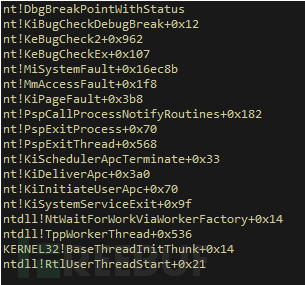
从崩溃信息中我们可以看到,Bam.sys注册了一个进程创建回调,并且在卸载之前忘记注销它了。接下来,当一个进程被创建/终止时,系统会尝试调用这个回调,并引用旧指针,然后导致系统崩溃。

有趣的并不是系统发生崩溃,而是Bam.sys到底是如何注册这个回调的。一般来说,进程创建回调是通过nt!PsSetCreateProcessNotifyRoutine(Ex)注册的,它会向nt!PspCreateProcessNotifyRoutine数组中添加这个回调。接下来,当进程被创建/终止时,nt!PspCallProcessNotifyRoutines会迭代循环这个数组,并调用所有已注册的回调。然而,如果我们在WinDbg中运行“!wdbgark.wa_systemcb /typeprocess“的话,我们将会看到这个数组中并不存在Bam.sys所使用的回调:

原来,Bam.sys使用了另一种机制来注册它的回调:


查看nt!PspCallProcessNotifyRoutines后我们发现,其中有一个指向nt!PspBamExtensionHost的显示引用。它会使用这种“扩展主机”来检索所谓的“扩展表”,并调用扩展表中的第一个函数,即bam!BampCreateProcessCallback。
在IDA中打开Bam.sys,我们可以直接看到bam!BampCreateProcessCallback,并搜索它的xrefs。幸好它只有一个,就在bam!BampRegisterKernelExtension中:
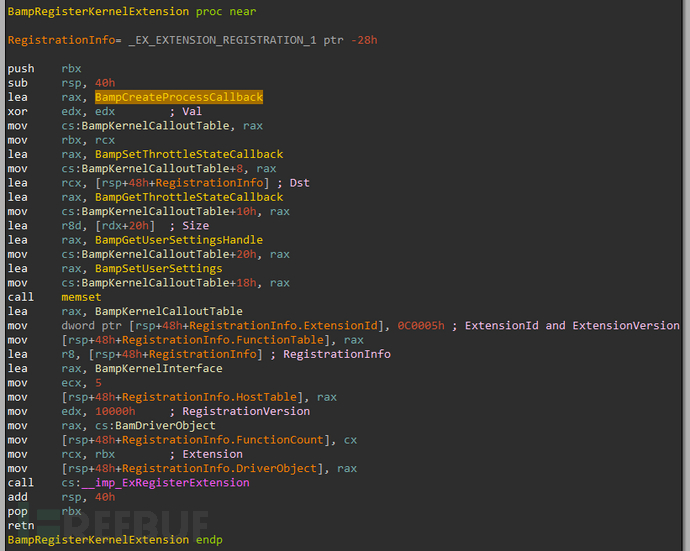
我怀疑Bam!BampCreateProcessCallback并没有通过常规的回调注册机制来进行注册。实际上,它被存在了一个名叫Bam!BampKernelCalloutTable的函数表中,而这个表会和其他参数一起传递给nt!ExRegisterExtension函数(文档中未记载)。
唯一一个我找到的跟这个函数相关的就是ntosifs.h头文件,其中包含了nt!ExRegisterExtension函数的原型以及_EX_EXTENSION_REGISTRATION_1结构体。
nt!ExRegisterExtension函数原型和_EX_EXTENSION_REGISTRATION_1:
NTKERNELAPINTSTATUS ExRegisterExtension ( _Outptr_ PEX_EXTENSION *Extension, _In_ ULONG RegistrationVersion, _In_ PVOID RegistrationInfo); typedefstruct _EX_EXTENSION_REGISTRATION_1 { USHORT ExtensionId; USHORT ExtensionVersion; USHORT FunctionCount; VOID *FunctionTable; PVOID *HostInterface; PVOID DriverObject;}EX_EXTENSION_REGISTRATION_1, *PEX_EXTENSION_REGISTRATION_1;注意:nt!ExRegisterExtension的伪代码可在附录B中找到。
我们可以看到,nt!ExRegisterExtension会搜索名称匹配RegistrationInfo的主机。那么问题来了,这些主机是从哪儿来的呢?
在初始化的过程中,NTOS会多次调用nt!ExRegisterHost。每次调用时,它都会传递一个结构体来识别列表中预定义的驱动器(完整列表可在附录A中找到)。比如说,Bam.sys会使用下列调用来初始化一台主机:
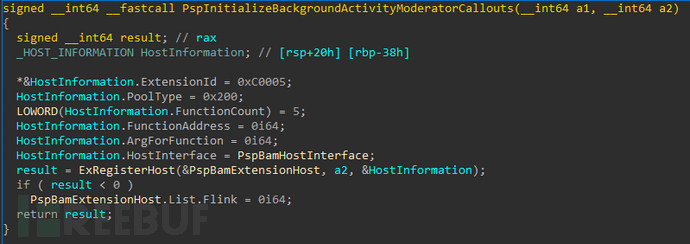
nt!ExRegisterHost会分配一个type_HOST_LIST_ENTRY结构体,并使用调用方提供的参数来进行初始化,然后将其添加到nt!ExpHostList结尾。_HOST_LIST_ENTRY结构体文档未记载,它的大致结构如下:
struct_HOST_LIST_ENTRY{ _LIST_ENTRY List; DWORD RefCount; USHORT ExtensionId; USHORT ExtensionVersion; USHORT FunctionCount; // number ofcallbacks that the extension // contains POOL_TYPE PoolType; // where this host is allocated PVOID HostInterface; // table of unexportednt functions, // to be used by thedriver to which // this extensionbelongs PVOID FunctionAddress; // optional, rarelyused. // This callback iscalled before // and after anextension for this // host isregistered / unregistered PVOID ArgForFunction; // will be sent tothe function saved here _EX_RUNDOWN_REF RundownRef; _EX_PUSH_LOCK Lock; PVOID FunctionTable; // a table of thecallbacks that the // driver “registers” DWORD Flags; // Only uses one bit. // Not sure about itsmeaning.}HOST_LIST_ENTRY, *PHOST_LIST_ENTRY;当其中一个预定义的驱动器加载时,它会使用nt!ExRegisterExtension注册一个扩展,并提供一个RegistrationInfo结构体,其中包括一个函数表。这个函数表会被置入匹配主机的FunctionTable成员中。这些函数随后会被NTOS在特定的场景下调用,这也就是所谓的回调了。
之前我们看到了nt!ExRegisterExtension的部分功能会被设置为RegistrationInfo->HostInterface(包含一个全局变量),并指向主机结构体中的某些数据。
每一个注册了扩展的驱动器都有一个NTOS设置的初始化主机,这种主机包含一个HostInterface,它指向HTOS函数预定一个一个表,不同的驱动器会收到不同的HostInterface,但有些则不会收到。
比如说,Bam.sys收到的就是下面这个HostInterface:

实际上,这里所谓的“内核扩展机制”即使一种双向通信端口:驱动器提供一个“回调”列表,以供在不同场景下调用,然后在各自内部使用场景中接收不同的函数集。
下面给出的是Bam.sys的回调样本:
BampCreateProcessCallbackBampSetThrottleStateCallbackBampGetThrottleStateCallbackBampSetUserSettingsBampGetUserSettingsHandle
负责Bam.sys初始化的主机预先“知道”它需要接收包含上面这5个函数的函数表。这些函数必须按照上述顺序提供,因此这里是通过索引来调用的。我们可以看到,nt!PspBamExtensionHost->FunctionTable[4]调用情况:
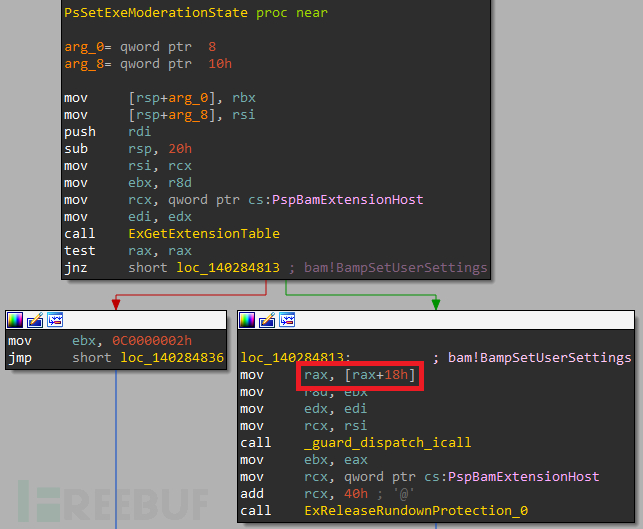
总而言之,Windows中存在一种机制,可以用来“扩展”NTOS,具体过程是先注册某些回调函数,然后接收驱动可以使用的未导出函数。我并不清楚这个知识点是否能发挥实际作用,但觉得这方面内容比较有趣,值得与大家分享。希望可以给大家提供帮助,感谢阅读!
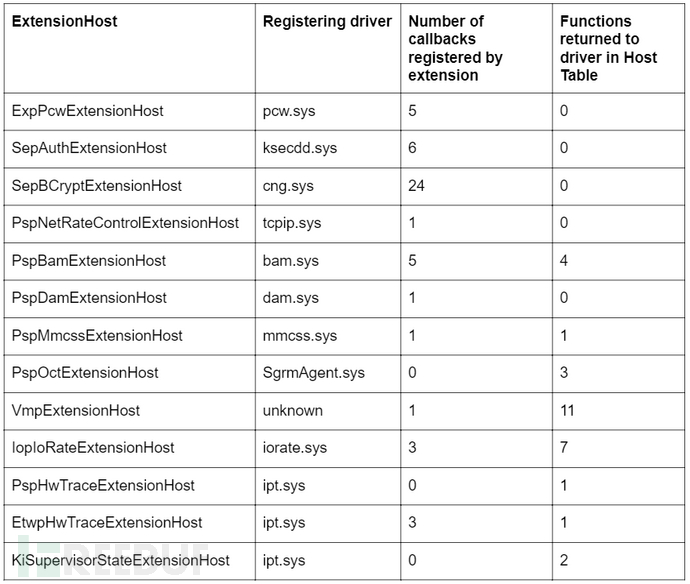
NTSTATUSExRegisterExtension(_Outptr_ PEX_EXTENSION *Extension, _In_ ULONGRegistrationVersion, _In_ PREGISTRATION_INFO RegistrationInfo){ // Validate that version is ok and thatFunctionTable is not sent without FunctionCount or vise-versa. if ( (RegistrationVersion &0xFFFF0000 != 0x10000) || (RegistrationInfo->FunctionTable == nullptr&& RegistrationInfo->FunctionCount != 0) ) { return STATUS_INVALID_PARAMETER; } // Skipping over some lock-related stuff, // Find the host with the matchingversion and id. PHOST_LIST_ENTRY pHostListEntry; pHostListEntry =ExpFindHost(RegistrationInfo->ExtensionId,RegistrationInfo->ExtensionVersion); // More lock-related stuff. if (!pHostListEntry) { return STATUS_NOT_FOUND; } // Verify that the FunctionCount in thehost doesn't exceed the FunctionCount supplied by the caller. if (RegistrationInfo->FunctionCount< pHostListEntry->FunctionCount) { ExpDereferenceHost(pHostListEntry); return STATUS_INVALID_PARAMETER; } // Check that the number of functions inFunctionTable matches the amount in FunctionCount. PVOID FunctionTable =RegistrationInfo->FunctionTable; for (int i = 0; i <RegistrationInfo->FunctionCount; i++) { if (RegistrationInfo->FunctionTable[i] == nullptr ) { ExpDereferenceHost(pHostListEntry); returnSTATUS_ACCESS_DENIED; } } // skipping over some more lock-relatedstuff // Check if there is already an extensionregistered for this host. if (pHostListEntry->FunctionTable !=nullptr || FlagOn(pHostListEntry->Flags, 1) ) { // There is something related tolocks here ExpDereferenceHost(pHostListEntry); returnSTATUS_OBJECT_NAME_COLLISION; } // If there is a callback function forthis host, call it before registering the extension, with 0 as the firstparameter. if (pHostListEntry->FunctionAddress) { pHostListEntry->FunctionAddress(0,pHostListEntry->ArgForFunction); } // Set the FunctionTable in the host tothe table supplied by the caller, or to MmBadPointer if a table wasn'tsupplied. if (RegistrationInfo->FunctionTable ==nullptr) { pHostListEntry->FunctionTable= nt!MmBadPointer; } else { pHostListEntry->FunctionTable= RegistrationInfo->FunctionTable; } pHostListEntry->RundownRef = 0; // If there is a callback function forthis host, call it after registering the extension, with 1 as the firstparameter. if (pHostListEntry->FunctionAddress) { pHostListEntry->FunctionAddress(1,pHostListEntry->ArgForFunction); } // Here there is some more lock-relatedstuff // Set the HostTable of the callingdriver to the table of functions listed in the host. if (RegistrationInfo->HostTable !=nullptr) { *(PVOID)RegistrationInfo->HostTable= pHostListEntry->hostInterface; } // Return the initialized host to thecaller in the output Extension parameter. *Extension = pHostListEntry; return STATUS_SUCCESS;}NTSTATUSExRegisterHost(_Out_ PHOST_LIST_ENTRY ExtensionHost, _In_ ULONG Unused, _In_PHOST_INFORMATION HostInformation){ NTSTATUS Status = STATUS_SUCCESS; // Allocate memory for a newHOST_LIST_ENTRY PHOST_LIST_ENTRY p =ExAllocatePoolWithTag(HostInformation->PoolType, 0x60, 'HExE'); if (p == nullptr) { returnSTATUS_INSUFFICIENT_RESOURCES; } // // Initialize a new HOST_LIST_ENTRY // p->Flags &= 0xFE; p->RefCount = 1; p->FunctionTable = 0; p->ExtensionId =HostInformation->ExtensionId; p->ExtensionVersion =HostInformation->ExtensionVersion; p->hostInterface =HostInformation->hostInterface; p->FunctionAddress =HostInformation->FunctionAddress; p->ArgForFunction =HostInformation->ArgForFunction; p->Lock = 0; p->RundownRef = 0; // Search for an existing listEntry withthe same version and id. PHOST_LIST_ENTRY listEntry = ExpFindHost(HostInformation->ExtensionId,HostInformation->ExtensionVersion); if (listEntry) { Status =STATUS_OBJECT_NAME_COLLISION; ExpDereferenceHost(p); ExpDereferenceHost(listEntry); } else { // Insert the new HOST_LIST_ENTRYto the end of ExpHostList. if ( *lastHostListEntry !=&firstHostListEntry ) { __fastfail(); } firstHostListEntry->Prev =&p; p->Next = firstHostListEntry; lastHostListEntry = p; ExtensionHost = p; } return Status;}PHOST_LIST_ENTRYExpFindHost(USHORT ExtensionId, USHORT ExtensionVersion){ PHOST_LIST_ENTRY entry; for (entry == ExpHostList; ; entry =entry->Next) { if (entry == &ExpHostList) { return 0; } if ( *(entry->ExtensionId) ==ExtensionId && *(entry->ExtensionVersion) == ExtensionVersion ) { break; } }InterlockedIncrement(entry->RefCount); return entry;}voidExpDereferenceHost(PHOST_LIST_ENTRY Host){ if (InterlockedExchangeAdd(Host.RefCount, 0xFFFFFFFF) == 1 ) { ExFreePoolWithTag(Host, 0); }}struct_HOST_INFORMATION{ USHORT ExtensionId; USHORT ExtensionVersion; DWORD FunctionCount; POOL_TYPE PoolType; PVOID HostInterface; PVOID FunctionAddress; PVOID ArgForFunction; PVOID unk;}HOST_INFORMATION, *PHOST_INFORMATION; struct_HOST_LIST_ENTRY{ _LIST_ENTRY List; DWORD RefCount; USHORT ExtensionId; USHORT ExtensionVersion; USHORT FunctionCount; // number ofcallbacks that the // extension contains POOL_TYPE PoolType; // where this host is allocated PVOID HostInterface; // table of unexported nt functions, // to be used by thedriver to which // this extensionbelongs PVOID FunctionAddress; // optional, rarelyused. // This callback iscalled before and // after anextension for this host // is registered /unregistered PVOID ArgForFunction; // will be sent tothe function saved here _EX_RUNDOWN_REF RundownRef; _EX_PUSH_LOCK Lock; PVOID FunctionTable; // a table of the callbacks that // the driver“registers”DWORDFlags; // Only uses oneflag. // Not sure about its meaning.}HOST_LIST_ENTRY, *PHOST_LIST_ENTRY;; struct_EX_EXTENSION_REGISTRATION_1{ USHORT ExtensionId; USHORT ExtensionVersion; USHORT FunctionCount; PVOID FunctionTable; PVOID *HostTable; PVOID DriverObject;}EX_EXTENSION_REGISTRATION_1,*PEX_EXTENSION_REGISTRATION_1;看完上述内容是否对您有帮助呢?如果还想对相关知识有进一步的了解或阅读更多相关文章,请关注亿速云行业资讯频道,感谢您对亿速云的支持。
免责声明:本站发布的内容(图片、视频和文字)以原创、转载和分享为主,文章观点不代表本网站立场,如果涉及侵权请联系站长邮箱:is@yisu.com进行举报,并提供相关证据,一经查实,将立刻删除涉嫌侵权内容。